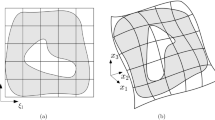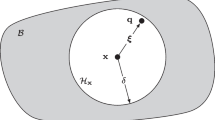Abstract
To achieve the exponential rates of convergence possible with the p-version finite element method requires properly constructed meshes. In the case of piecewise smooth domains, these meshes are characterized by having large curved elements over smooth portions of the domain and geometrically graded curved elements to isolate the edge and vertex singularities that are of interest. This paper presents a procedure under development for the automatic generation of such meshes for general three-dimensional domains defined in solid modeling systems. Two key steps in the procedure are the determination of the singular model edges and vertices, and the creation of geometrically graded elements around those entities. The other key step is the use of general curved element mesh modification procedures to correct any invalid elements created by the curving of mesh entities on the model boundary, which is required to ensure a properly geometric approximation of the domain. Example meshes are included to demonstrate the features of the procedure.



















Similar content being viewed by others
Notes
A mesh face or edge that lies on a model face is “classified on that model face” and a mesh edge that lies on a model classified on a model edge is “classified on that model edge.”
References
Anderson B, Falk U, Babuska I, Petersdorff TV (1995) Reliable stress and fracture mechanics analysis of complex components using a hp version of FEM. Int J Numer Methods Eng 38:2135–2163
Babuska I, Suri M (1994) The p and h-p versions of the finite element method, basic principles and properties. SIAM Rev 36(4):578–632
Babuska I, Petersdorff TV, Anderson B (1994) Numerical treatment of vertex singularities and intensity factors for mixed boundary value problems for the Laplace equation. SIAM J Numer Anal 31(5):1265–1288
Babuska I, Anderson B, Guo B, Melenk JM, Oh HS (1996) Finite element method for solving problems with singular solutions. J Comp Appl Math 74:51–70
Dey S, O’Bara RM, Shephard MS (2001) Towards curvilinear meshing in 3D: the case of quadratic simplices. CAD Comput Aided Des 33(3):199–209
Dey S, Shephard MS, Flaherty JE (1997) Geometry representation issues associated with p-version finite element computations. Comput Methods Appl Mech Eng 150(1–4):39–55
Dorr MR (1986) The approximation of solutions of elliptic boundary-value problems via the p-version of the finite element method. SIAM J Numer Anal 23(1):58–77
Farin GE (1993) Curves and surfaces for computer aided geometric design: a practical guide, 3rd edn. Academic Press, Boston
Farouki RT, Rajan VT (1988) Algorithms for polynomials in Bernstein. Comput Aided Geom Des 5:1–26
Garimella R, Shephard MS (2000) Boundary layer mesh generation for viscous flow simulations in complex geometric domains. Int J Numer Methods Eng 49(1–2):193–218
Harber R, Shephard MS, Abel JF, Gallagher RH, Greenberg DP (1981) A general two-dimensional, graphical finite element preprocessor utilizing discrete transfinite mappings. Int J Numer Methods Eng 17:1015–1044
Li X, Shephard MS, Beall MW (2003) 3-D anisotropic mesh adaptation by mesh modifications. Comput Methods Appl Mech Eng (submitted)
Luo XJ, Shephard MS, Remacle JF, O’Bara RM, Beall MW, Szabo BA, Actis R (2002) p-version mesh generation issues. In: Proceedings of the 11th international meshing roundtable, Ithaca, New York, September 2002. Sandia National Laboratories, pp 343–354
Sherwin SJ, Peiro J (2002) Mesh generation in curvilinear domains using high order elements. Int J Numer Methods Eng 53:207–223
Szabo BA (1986) Mesh design for the p-version of the finite element method. Comput Methods Appl Mech Eng 55:181–197
Szabo BA, Babuska I (1991) Finite element analysis. Wiley, New York
Acknowledgements
This work was supported by the National Science Foundation through SBIR grant number DMI-0132742.
Author information
Authors and Affiliations
Corresponding author
Rights and permissions
About this article
Cite this article
Luo, XJ., Shephard, M.S., O’Bara, R.M. et al. Automatic p-version mesh generation for curved domains. Engineering with Computers 20, 273–285 (2004). https://doi.org/10.1007/s00366-004-0295-1
Received:
Accepted:
Published:
Issue Date:
DOI: https://doi.org/10.1007/s00366-004-0295-1




